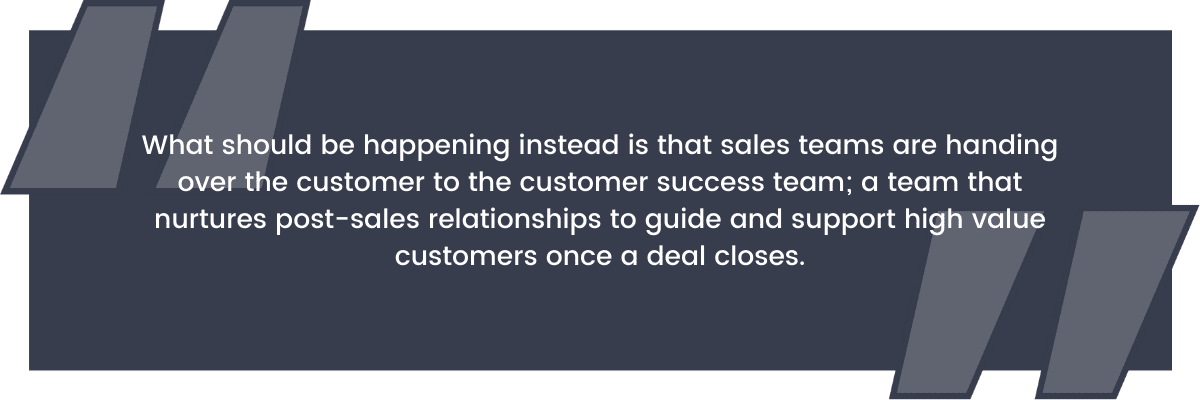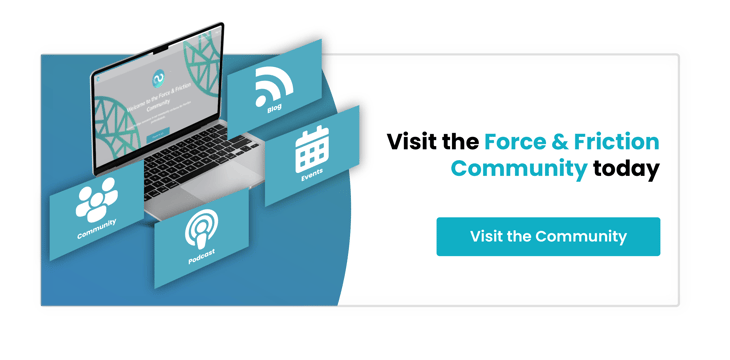
The Sales Handoff Template - Your Process to Drive Customer Success
The marketing/sales handoff is often discussed. What isn’t discussed quite as often, however, is the handoff that’s needed from sales teams to customer success teams.
What really happens once sales has done its job? What *should* be happening? And how can sales managers do their part to ensure that the transition goes as smoothly as possible? And perhaps the biggest question of all: why is the transition to customer success all that important anyway? This guide answers all those questions, and more.
What Happens When Sales Has Done Its Job?
In many cases, once a sales rep closes a deal, they’ll want to draw that customer back into the sales pipeline. After all, this contact has demonstrated strong interest in the business and has proven that they’re willing to take action. They’re the ideal lead. But it’s not always easy to draw customers back in so quickly, especially following a high value deal.

But why is this so important?
There are two reasons why handing off to customer success teams is critical:
- Keeping customers warm - Customer success agents can keep a customer warm until they’re ready to engage with marketing and sales teams again. It’s a process that doesn’t push or drive a hard sell, but which also doesn’t let a customer become lost. It nurtures them as they prepare to restart the buyer’s journey.
- Turning customers into promoters - Even in cases where a customer may not become a repeat customer, the customer success team can provide opportunities for them to share positive experiences. Former customers, when nurtured, can be valuable promoters, advocates, and influencers for future customers.
But doesn’t this all happen organically? Don’t customer success teams simply jump in when a deal closes? They do… and that’s the problem. When there’s no standardised process for moving a contact from customer to promoter, there are a number of risks.
Most worryingly is the risk of the customer success team falling into the ‘danger zone’; a state where the agent begins to forget some of the key details relating to the deal, which can make it difficult - if not impossible - to create a personalised experience.
That’s why it's so important to build an effective sales handoff template that acts as a playbook, covering everything that sales reps need to do for a seamless handover and frictionless selling further down the line. Having this and other processes documented is even more critical if you’re considering how to build a remote sales team which performs at a high level to deliver on your inbound sales goals.

What is a Sales Handoff Playbook?
A sales handoff playbook is a document that brings together everything that both sales reps and customer success agents will need to create a smooth transition for the customer. Each playbook will be different, but should always include three elements:
- Clear Expectations
Every sales handoff playbook should focus on expectations; not only what sales reps and customer success agents expect from each other, but also what the customer expects from the experience itself. The latter is perhaps the most important. With a better understanding of customer expectations, both parties can develop a strategy that effectively manages these expectations to reduce the risk of customer churn.
- Detailed Customer Notes
Timing is everything when it comes to a successful handoff; customer success agents must be able to step in quickly as needed, and really hit the ground running. And they’re only going to be able to do that if the sales handoff playbook contains detailed notes relating to the customer experience. When customer success agents have the full story, it’s possible to remove sticking points in the process and manage needs quickly.
- A Definition of Success
What does success really mean? While the definition of success can often vary, it’s important that the playbook features a standardised description of the term that is accepted across both sales teams and customer success teams.

How to Build a Sales Handoff Template
Once it’s clear what actually goes into a handoff playbook, it’s time to build a simple sales handoff template that can help you to design and develop a playbook that delivers. Sadly, there’s no single template that will meet the needs of every business, but there are 5 core elements that can help you to create a template that works for you:

1. Alignment
Perhaps the most important foundation of a good sales handoff template is ensuring that it works for both the sales team, and for the customer success team. And the best way to achieve this is by making sure that sales and customer success are aligned; that both teams are working towards a similar, shared goal. If they both share a vision for the overall customer experience, it’s easy to get the teams working together to drive results.
2. Relationships
When it comes to effective communications and knowledge sharing between the teams, it’s always easier when the teams know each other and get on well. If you’re currently operating in silos, it’s time to break down the barriers and encourage better cross-departmental activities and exercises to build better and more impactful relationships. Create a ‘buddy system’, and send buddies off for lunch or coffee.
3. Note Templates
One of the three key features of a sales handoff playbook is detailed customer notes… but as you might have already discovered, asking your sales team to spend time on admin tasks doesn’t always go down well! It’s important to offer your team a quick and simple way to record details, such as a note template with pre-designed fields to be filled in. Templates also ensure that sales reps don’t overlook anything of importance.
4. Feedback
The perfect sales handoff template allows for trial and error. Not everything is going to work out perfectly every single time, so sales managers should make sure they’re tracking and monitoring use of the playbook, identifying when it’s not being used correctly, evaluating the impact, and feeding this impact back to the sales rep. A good template shouldn’t be stagnant; it should allow for flexibility as and when required.
5. Resources
Finally, sales managers should ensure that both their sales reps and the customer success team know where to look for help and support should they need it. If there’s a sticking point in the handover process, it’s essential - from a timing perspective especially - that both teams know which person can help them out. Create resources that outline special individual skills so that both teams know who they can turn to.








%20-%20Teal.png?width=500&height=130&name=Force%20%26%20Friction%20-%20Branding%20-%20Logo%20(White)%20-%20Teal.png)